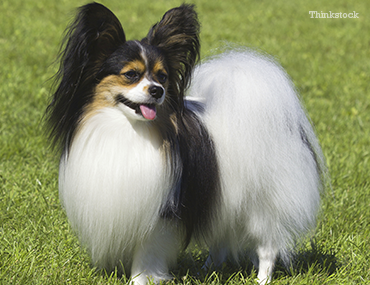Background:
Like most toy dogs, the Papillon was a favorite of royalty in the 17th and 18th centuries. They’re depicted in paintings as far back as the 15th century during which time they caught the eye of more than a few prominent artists.
Known as “dwarf Spaniels” during the centuries prior to the French revolution, the Papillon made his way into the lives of several historical figures including Marie Antoinette.
The Papillon came close to extinction following the French revolution, but made a comeback in the 19th century and was renamed after the French word for Butterfly. Not all Papillons are born with the signature butterfly ears however, and even pups in the same litter might have different ear types. Meaning some will have floppy and others butterfly.
Sizing up:
- Weight: 3 to 12 lbs
- Height: 8 to 11 inches
- Colors: Black brown and white, black red and white, white and black, white and lemon, white and red, white and sable, hound tri-color, white and black, brown and white, fawn and white, red, red white and sable, sable, white, white and liver, white and silver.
- Coat: Life Expectancy: 13 to 17 years
What’s the Papillon like?
Don’t be fooled by a Papillion’s size. He can be as loud and destructive as the big boys. Fortunately if you provide him with proper exercise and training you’ll never have to experience these negative traits.
It’s best if you think of a Papillon as a spunky adventurous and sociable dog. Not as a spoiled lap dog who would like to lie around with you all day. While he will lie in your lap it’s certainly not the reason he gets up in the morning. The Papillon enjoys running at full speed, off leash, and could even participate in agility competitions.
Health:
The Papillon has very few health problems, but you should still watch for a few conditions:
Takeaway points:
- The Papillon requires at least one walk per day
- The Papillon is very sociable
- The Papillon is not great with children
If you have any questions or concerns, you should always visit or call your veterinarian – they are your best resource to ensure the health and well-being of your pets.
![]()

